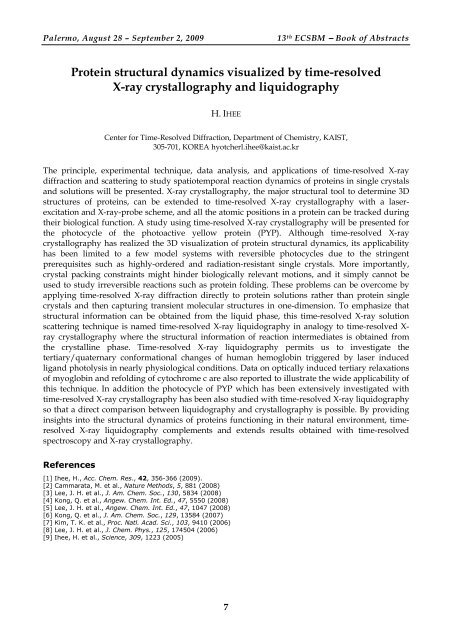XIII European Conference on the Spectroscopy of ... - ecsbm 2009
XIII European Conference on the Spectroscopy of ... - ecsbm 2009
XIII European Conference on the Spectroscopy of ... - ecsbm 2009
You also want an ePaper? Increase the reach of your titles
YUMPU automatically turns print PDFs into web optimized ePapers that Google loves.
Palermo, August 28 – September 2, <strong>2009</strong> 13 th ECSBM −−−− Book <strong>of</strong> Abstracts<br />
Protein structural dynamics visualized by time-resolved<br />
X-ray crystallography and liquidography<br />
H. IHEE<br />
Center for Time-Resolved Diffracti<strong>on</strong>, Department <strong>of</strong> Chemistry, KAIST,<br />
305-701, KOREA hyotcherl.ihee@kaist.ac.kr<br />
The principle, experimental technique, data analysis, and applicati<strong>on</strong>s <strong>of</strong> time-resolved X-ray<br />
diffracti<strong>on</strong> and scattering to study spatiotemporal reacti<strong>on</strong> dynamics <strong>of</strong> proteins in single crystals<br />
and soluti<strong>on</strong>s will be presented. X-ray crystallography, <strong>the</strong> major structural tool to determine 3D<br />
structures <strong>of</strong> proteins, can be extended to time-resolved X-ray crystallography with a laserexcitati<strong>on</strong><br />
and X-ray-probe scheme, and all <strong>the</strong> atomic positi<strong>on</strong>s in a protein can be tracked during<br />
<strong>the</strong>ir biological functi<strong>on</strong>. A study using time-resolved X-ray crystallography will be presented for<br />
<strong>the</strong> photocycle <strong>of</strong> <strong>the</strong> photoactive yellow protein (PYP). Although time-resolved X-ray<br />
crystallography has realized <strong>the</strong> 3D visualizati<strong>on</strong> <strong>of</strong> protein structural dynamics, its applicability<br />
has been limited to a few model systems with reversible photocycles due to <strong>the</strong> stringent<br />
prerequisites such as highly-ordered and radiati<strong>on</strong>-resistant single crystals. More importantly,<br />
crystal packing c<strong>on</strong>straints might hinder biologically relevant moti<strong>on</strong>s, and it simply cannot be<br />
used to study irreversible reacti<strong>on</strong>s such as protein folding. These problems can be overcome by<br />
applying time-resolved X-ray diffracti<strong>on</strong> directly to protein soluti<strong>on</strong>s ra<strong>the</strong>r than protein single<br />
crystals and <strong>the</strong>n capturing transient molecular structures in <strong>on</strong>e-dimensi<strong>on</strong>. To emphasize that<br />
structural informati<strong>on</strong> can be obtained from <strong>the</strong> liquid phase, this time-resolved X-ray soluti<strong>on</strong><br />
scattering technique is named time-resolved X-ray liquidography in analogy to time-resolved Xray<br />
crystallography where <strong>the</strong> structural informati<strong>on</strong> <strong>of</strong> reacti<strong>on</strong> intermediates is obtained from<br />
<strong>the</strong> crystalline phase. Time-resolved X-ray liquidography permits us to investigate <strong>the</strong><br />
tertiary/quaternary c<strong>on</strong>formati<strong>on</strong>al changes <strong>of</strong> human hemoglobin triggered by laser induced<br />
ligand photolysis in nearly physiological c<strong>on</strong>diti<strong>on</strong>s. Data <strong>on</strong> optically induced tertiary relaxati<strong>on</strong>s<br />
<strong>of</strong> myoglobin and refolding <strong>of</strong> cytochrome c are also reported to illustrate <strong>the</strong> wide applicability <strong>of</strong><br />
this technique. In additi<strong>on</strong> <strong>the</strong> photocycle <strong>of</strong> PYP which has been extensively investigated with<br />
time-resolved X-ray crystallography has been also studied with time-resolved X-ray liquidography<br />
so that a direct comparis<strong>on</strong> between liquidography and crystallography is possible. By providing<br />
insights into <strong>the</strong> structural dynamics <strong>of</strong> proteins functi<strong>on</strong>ing in <strong>the</strong>ir natural envir<strong>on</strong>ment, timeresolved<br />
X-ray liquidography complements and extends results obtained with time-resolved<br />
spectroscopy and X-ray crystallography.<br />
References<br />
[1] Ihee, H., Acc. Chem. Res., 42, 356-366 (<strong>2009</strong>).<br />
[2] Cammarata, M. et al., Nature Methods, 5, 881 (2008)<br />
[3] Lee, J. H. et al., J. Am. Chem. Soc., 130, 5834 (2008)<br />
[4] K<strong>on</strong>g, Q. et al., Angew. Chem. Int. Ed., 47, 5550 (2008)<br />
[5] Lee, J. H. et al., Angew. Chem. Int. Ed., 47, 1047 (2008)<br />
[6] K<strong>on</strong>g, Q. et al., J. Am. Chem. Soc., 129, 13584 (2007)<br />
[7] Kim, T. K. et al., Proc. Natl. Acad. Sci., 103, 9410 (2006)<br />
[8] Lee, J. H. et al., J. Chem. Phys., 125, 174504 (2006)<br />
[9] Ihee, H. et al., Science, 309, 1223 (2005)<br />
7


